Considering Water Quality of Urban Rivers from the Perspectives of Unpleasant Odor
Abstract
:1. Introduction
2. Materials and Methods
2.1. Study Site
2.2. Data Source
2.3. Hedonic Tones of Odor and the Derivation of Odor Score
3. Results
3.1. Transition of Unpleasant Odor at the Shakujii and the Kanda Rivers
3.2 The Concentrations of DO and BOD
4. Discussion
5. Conclusions
Author Contributions
Conflicts of Interest
References
- Aylward, B.; Bandyopadhyay, J.; Belausteguigotia, J.-C.; Börkey, P.; Cassar, A.; Meadors, L.; Saade, L.; Siebentritt, M.; Stein, R.; Tognetti, S.; et al. Freshwater Ecosystem Services. In Ecosystems and Human Well-Being: Policy Responses; Island Press: Washington, DC, USA, 2005; pp. 213–255. ISBN 9781559632706. [Google Scholar]
- Lambin, E.F.; Turner, B.L.; Geist, H.J.; Agbola, S.B.; Angelsen, A.; Bruce, J.W.; Coomes, O.T.; Dirzo, R.; Fischer, G.; Folke, C.; et al. The causes of land-use and land-cover change: Moving beyond the myths. Glob. Environ. Chang. 2001, 11, 261–269. [Google Scholar] [CrossRef]
- Wolf, K.L.; Robbins, A.S.T.T. Metro nature, environmental health, and economic value. Environ. Health Perspect. 2015, 123, 390–398. [Google Scholar] [CrossRef] [PubMed]
- Barton, H. Land use planning and health and well-being. Land Use Policy 2009, 26, 115–123. [Google Scholar] [CrossRef]
- Kannel, P.R.; Lee, S.; Lee, Y.-S.; Kanel, S.R.; Khan, S.P. Application of Water Quality Indices and Dissolved Oxygen as Indicators for River Water Classification and Urban Impact Assessment. Environ. Monit. Assess. 2007, 132, 93–110. [Google Scholar] [CrossRef] [PubMed]
- Wang, J.; Da, L.; Song, K.; Li, B.-L. Temporal variations of surface water quality in urban, suburban and rural areas during rapid urbanization in Shanghai, China. Environ. Pollut. 2008, 152, 387–393. [Google Scholar] [CrossRef] [PubMed]
- Yamashita, S. Perception and evaluation of water in landscape: Use of Photo-Projective Method to compare child and adult residents’ perceptions of a Japanese river environment. Landsc. Urban Plan. 2002, 62, 3–17. [Google Scholar] [CrossRef]
- Pflüger, Y.; Rackham, A.; Larned, S. The aesthetic value of river flows: An assessment of flow preferences for large and small rivers. Landsc. Urban Plan. 2010, 95, 68–78. [Google Scholar] [CrossRef]
- Andrews, M.J. Thames Estuary: Pollution and recovery. In Effects of Pollutants at the Ecosystem Level; Sheehan, P.J., Miller, D.R., Butler, G.C., Bourdeau, P., Ridgeway, J.M., Eds.; John Wiley & Sons: Chichester, UK, 1984; pp. 195–228. [Google Scholar]
- Ayabe-Kanamura, S.; Schicker, I.; Laska, M.; Hudson, R.; Distel, H.; Kobayakawa, T.; Saito, S. Differences in perception of everyday odors: A Japanese-German cross-cultural study. Chem. Senses 1998, 23, 31–38. [Google Scholar] [CrossRef] [PubMed]
- Dravnieks, A.; Masurat, T.; Lamm, R.A. Hedonics of Odors and Odor Descriptors. J. Air Pollut. Control Assoc. 1984, 34, 752–755. [Google Scholar] [CrossRef]
- Sucker, K.; Both, R.; Bischoff, M.; Guski, R.; Winneke, G. Odor frequency and odor annoyance. Part I: Assessment of frequency, intensity and hedonic tone of environmental odors in the field. Int. Arch. Occup. Environ. Health 2008, 81, 671–682. [Google Scholar] [CrossRef] [PubMed]
- Nicell, J.A. Assessment and regulation of odor impacts. Atmos. Environ. 2009, 43, 196–206. [Google Scholar] [CrossRef]
- Sironi, S.; Capelli, L.; Céntola, P.; Del Rosso, R.; Il Grande, M. Odour emission factors for the prediction of odour emissions from plants for the mechanical and biological treatment of MSW. Atmos. Environ. 2006, 40, 7632–7643. [Google Scholar] [CrossRef]
- Hwang, Y.; Matsuo, T.; Hanaki, K.; Suzuki, N. Identification and quantification of sulfur and nitrogen containing odorous compounds in wastewater. Water Res. 1995, 29, 711–718. [Google Scholar] [CrossRef]
- Muezzinoglu, A. A study of volatile organic sulfur emissions causing urban odors. Chemosphere 2003, 51, 245–252. [Google Scholar] [CrossRef]
- Gostelow, P.; Parsons, S.A.; Stuetz, R.M. Odour measurements for sewage treatment works. Water Res. 2001, 35, 579–597. [Google Scholar] [CrossRef]
- Schiffman, S.S.; Williams, C.M. Science of odor as a potential health issue. J. Environ. Qual. 2005, 34, 129–138. [Google Scholar] [CrossRef] [PubMed]
- Kodama, K.; Horiguchi, T. Effects of hypoxia on benthic organisms in Tokyo Bay, Japan: A review. Mar. Pollut. Bull. 2011, 63, 215–220. [Google Scholar] [CrossRef] [PubMed]
- Naqvi, S.W.A.; Bange, H.W.; Bange, L.; Farías, P.M.S.; Scranton, M.I.; Zhang, J. Marine hypoxia/anoxia as a source of CH4 and N2O. Biogeosciences 2010, 7, 2159–2190. [Google Scholar] [CrossRef] [Green Version]
- Winneke, G.; Neuf, M.; Steinheider, B. Separating the impact of exposure and personality in annoyance response to environmental stressors, particularly odors. Environ. Int. 1996, 22, 73–81. [Google Scholar] [CrossRef]
- Kasanko, M.; Barredo, J.I.; Lavalle, C.; McCormick, N.; Demicheli, L.; Sagris, V.; Brezger, A. Are European cities becoming dispersed? A comparative analysis of 15 European urban areas. Landsc. Urban Plan. 2006, 77, 111–130. [Google Scholar] [CrossRef]
- Tagsold, C. Modernity, space and national representation at the Tokyo Olympics 1964. Urban Hist. 2010, 37, 289–300. [Google Scholar] [CrossRef]
- Chalkley, B.; Essex, S. Urban development through hosting international events: A history of the Olympic Games. Plan. Perspect. 1999, 14, 369–394. [Google Scholar] [CrossRef]
- Sorensen, A. Building world city Tokyo: Globalization and conflict over urban space. Ann. Reg. Sci. 2003, 37, 519–531. [Google Scholar] [CrossRef]
- Agus, E.; Zhang, L.; Sedlak, D.L. A framework for identifying characteristic odor compounds in municipal wastewater effluent. Water Res. 2012, 46, 5970–5980. [Google Scholar] [CrossRef] [PubMed]
- De Guardia, A.; Petiot, C.; Rogeau, D.; Druilhe, C. Influence of aeration rate on nitrogen dynamics during composting. Waste Manag. 2008, 28, 575–587. [Google Scholar] [CrossRef] [PubMed]
- Tatsuichi, S.; Iwasaki, Y.; Kayashima, M. Relationship between Threshold Odor Number and BOD of River Water. J. Jpn. Soc. Air Pollut. 1990, 25, 415–420. [Google Scholar] [CrossRef]
- Sawyer, C.N.; McCarty, P.L.; Parkin, G.F. Chemistry for Environmental Engineering, 4th ed.; McGraw-Hill: New York, NY, USA, 1994. [Google Scholar]
- Cox, B.A. A review of dissolved oxygen modelling techniques for lowland rivers. Sci. Total Environ. 2003, 314–316, 303–334. [Google Scholar] [CrossRef]
- Nihei, Y.; Yamaguchi, H.; Kashiwada, J.; Iwamoto, H. Do Environments in Tidal Rivers with Massive Fish Death. J. Jpn. Soc. Civ. Eng. 2009, B2-65, 1021–1025. [Google Scholar] [CrossRef]
- Rabalais, N.N.; Wiseman, W.J.; Turner, R.E. Comparison of continuous records of near-bottom dissolved oxygen from the hypoxia zone along the Louisiana coast. Estuaries 1994, 17, 850–861. [Google Scholar] [CrossRef]
- Ferrari, S.; Cribari-Neto, F. Beta Regression for Modelling Rates and Proportions. J. Appl. Stat. 2004, 31, 799–815. [Google Scholar] [CrossRef]
- Cribari-Neto, F.; Zeileis, A. Beta Regression in R. J. Stat. Softw. 2010, 34, 1–24. [Google Scholar] [CrossRef]
- Nordin, A.; Göttert, D.; Vinnerås, B. Decentralised black water treatment by combined auto-thermal aerobic digestion and ammonia—A pilot study optimising treatment capacity. J. Environ. Manag. 2018, 207, 313–318. [Google Scholar] [CrossRef] [PubMed]
- Ribera-Guardia, A.; Pijuan, M. Distinctive NO and N2O emission patterns in ammonia oxidizing bacteria: Effect of ammonia oxidation rate, DO and pH. Chem. Eng. J. 2017, 321, 358–365. [Google Scholar] [CrossRef]
- Eganhouse, R.P.; Sherblom, P.M. Anthropogenic organic contaminants in the effluent of a combined sewer overflow: Impact on Boston Harbor. Mar. Environ. Res. 2001, 51, 51–74. [Google Scholar] [CrossRef]
- Huntley, S.L.; Iannuzzi, T.J.; Avantaggio, J.D.; Carlson-Lynch, H.; Schmidt, C.W.; Finley, B.L. Combined sewer overflows (CSOs) as sources of sediment contamination in the lower Passaic River, New Jersey. II. Polychlorinated dibenzo-p-dioxins, polychlorinated dibenzofurans, and polychlorinated biphenyls. Chemosphere 1997, 34, 233–250. [Google Scholar] [CrossRef]
- Iannuzzi, T.J.; Huntley, S.L.; Schmidt, C.W.; Finley, B.L.; McNutt, R.P.; Burton, S.J. Combined sewer overflows (CSOs) as sources of sediment contamination in the lower Passaic River, New Jersey. 1. Priority pollutants, and inorganic chemicals. Chemosphere 1997, 34, 213–231. [Google Scholar] [CrossRef]
- Horie, N. Current Status of Combined Sewer System in Japan. Presented at Japan-Korea Special Workshop on Impact Assessment and Control of Combined Sewer Overflow, Tokyo, Japan, October 2011. [Google Scholar]
- Tibbetts, J. Combined sewer systems: Down, dirty, and out of date. Environ. Health Perspect. 2005, 113, A464–A467. [Google Scholar] [CrossRef] [PubMed]
- Urase, T. Aldehyde Type Odor as a Cause of Sewage Odor at the Tama River; The Tokyu Foundation for Better Environment: Tokyo, Japan, 2010. (In Japanese) [Google Scholar]
- Cleveland, W.S. Robust locally weighted regression and smoothing scatterplots. J. Am. Stat. Assoc. 1979, 74, 829–836. [Google Scholar] [CrossRef]
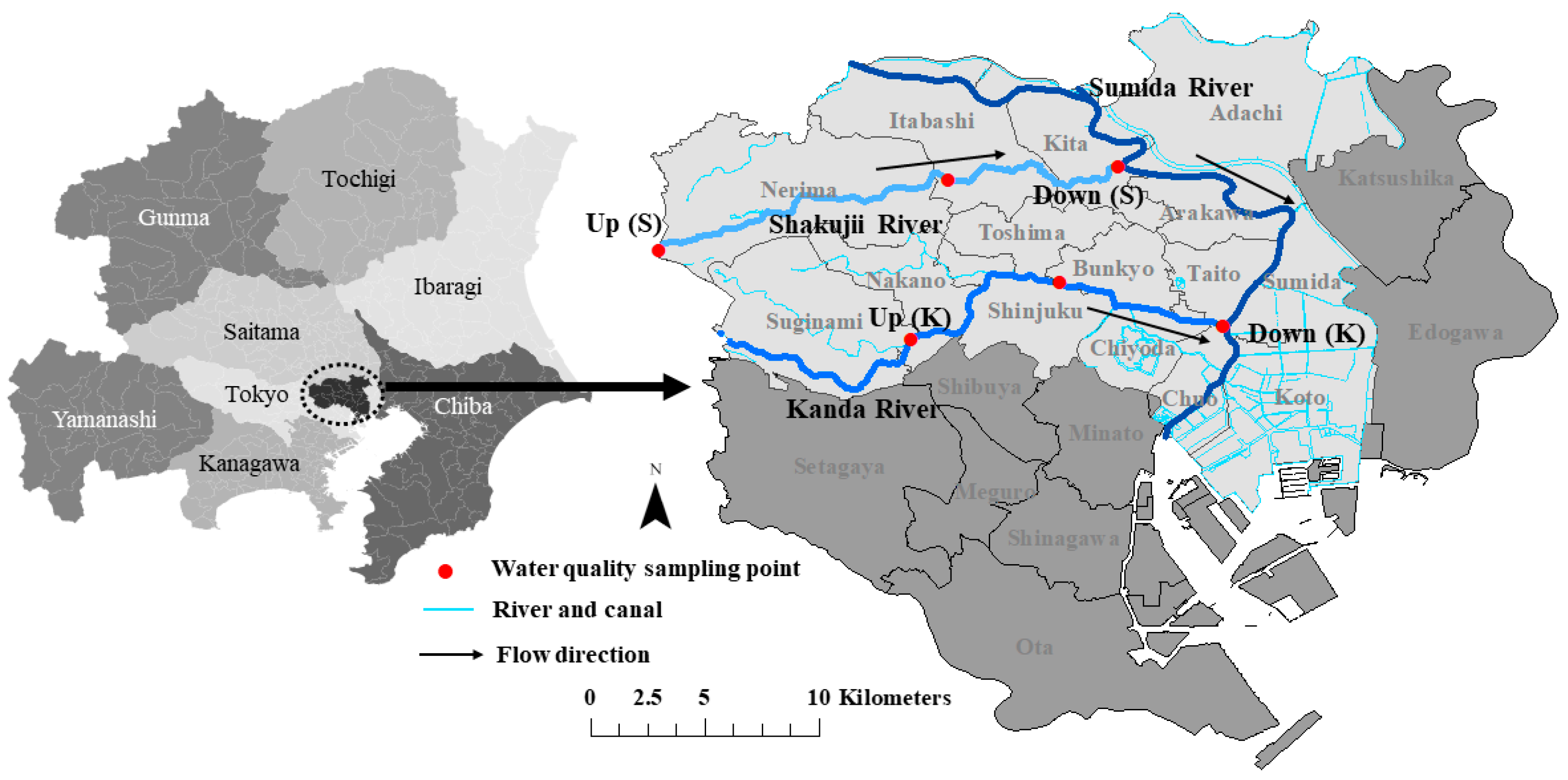
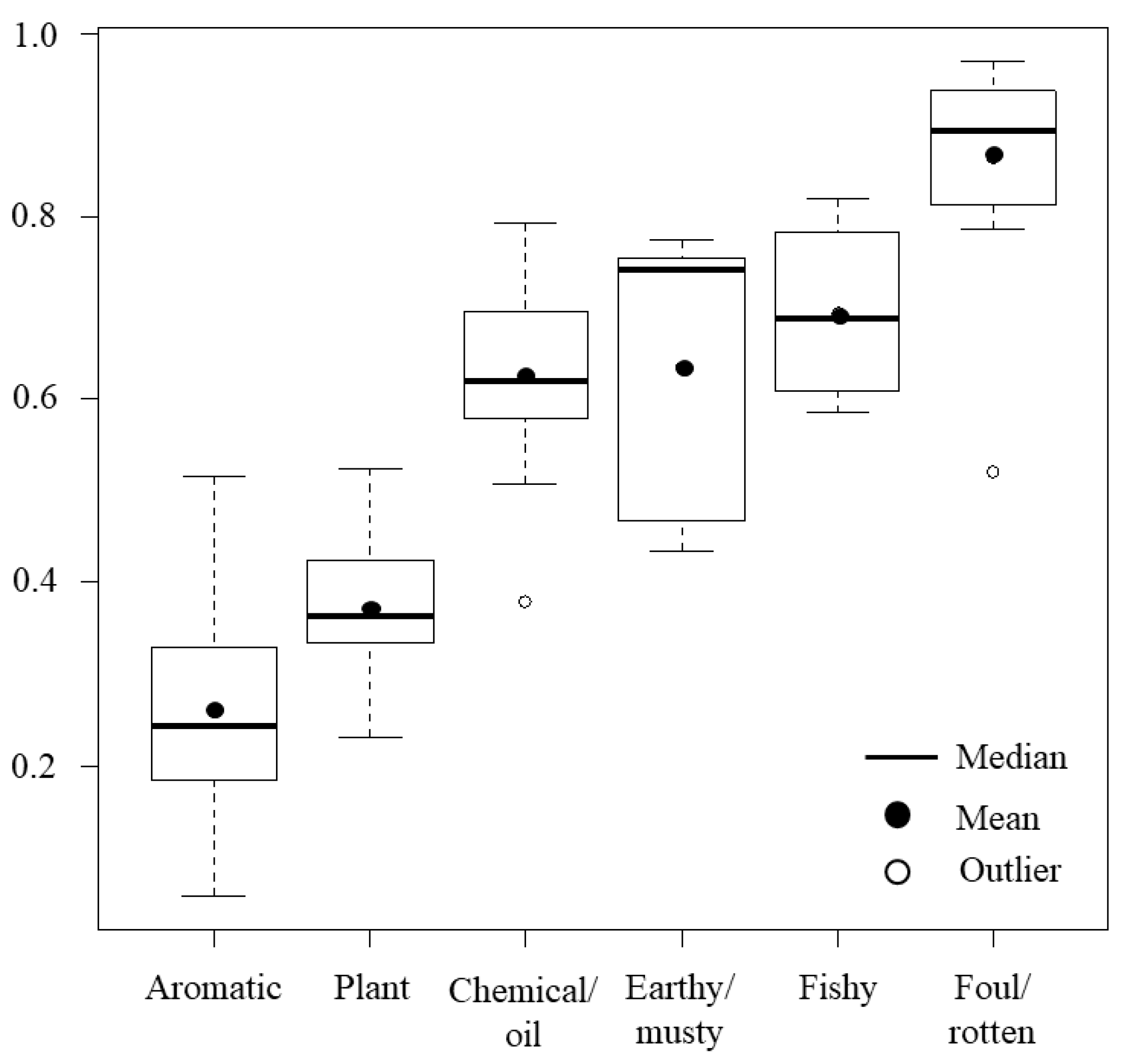
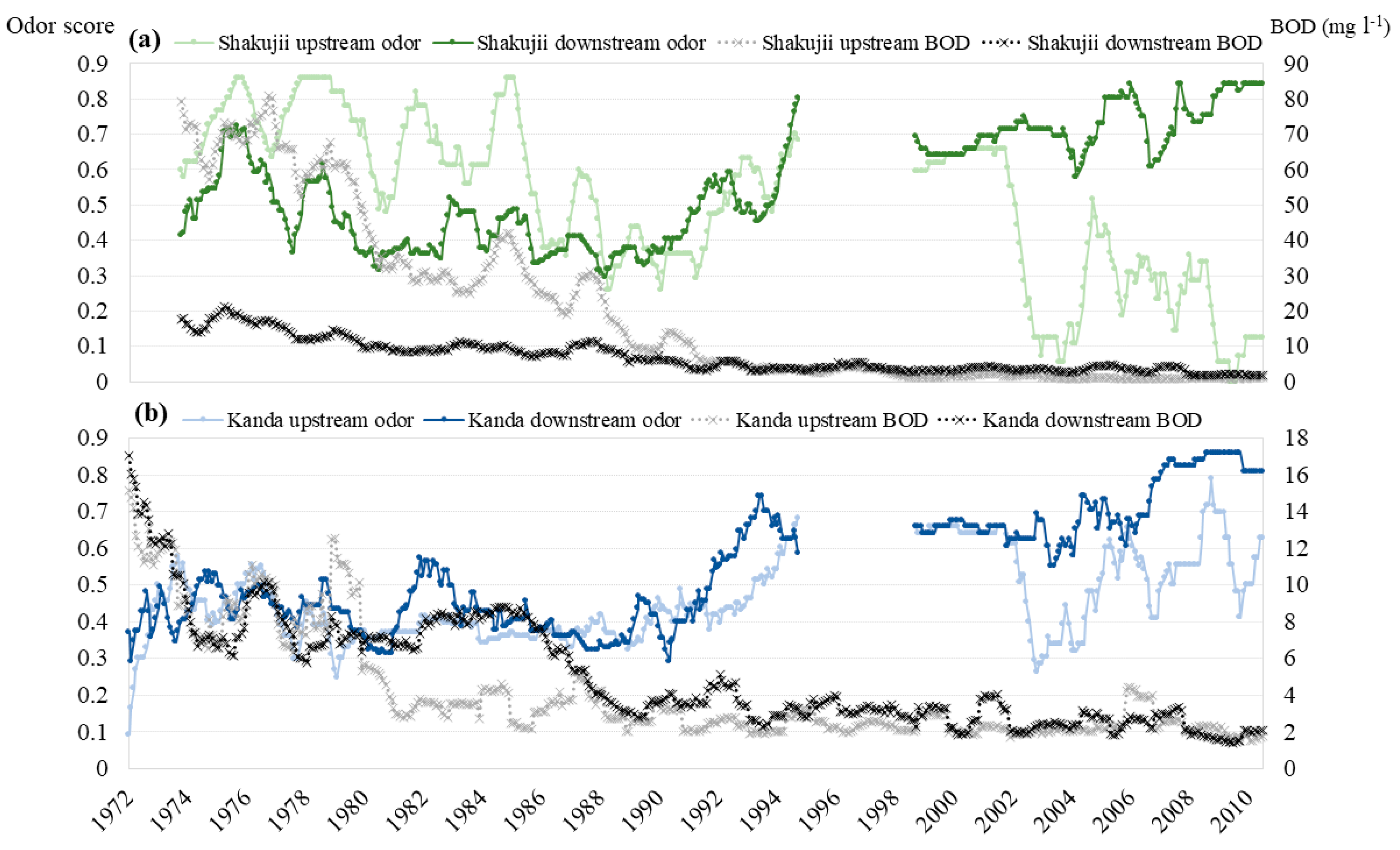
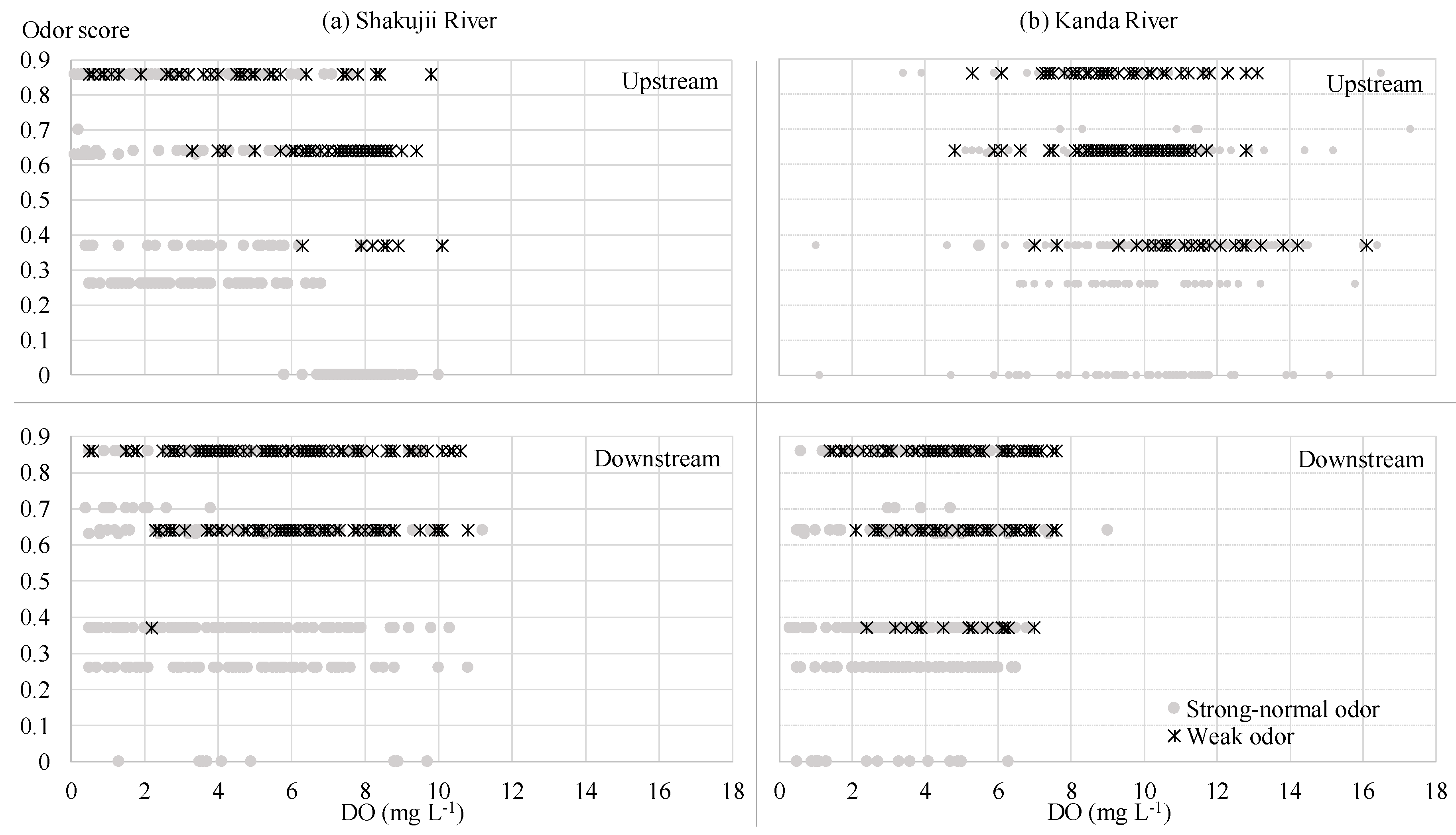
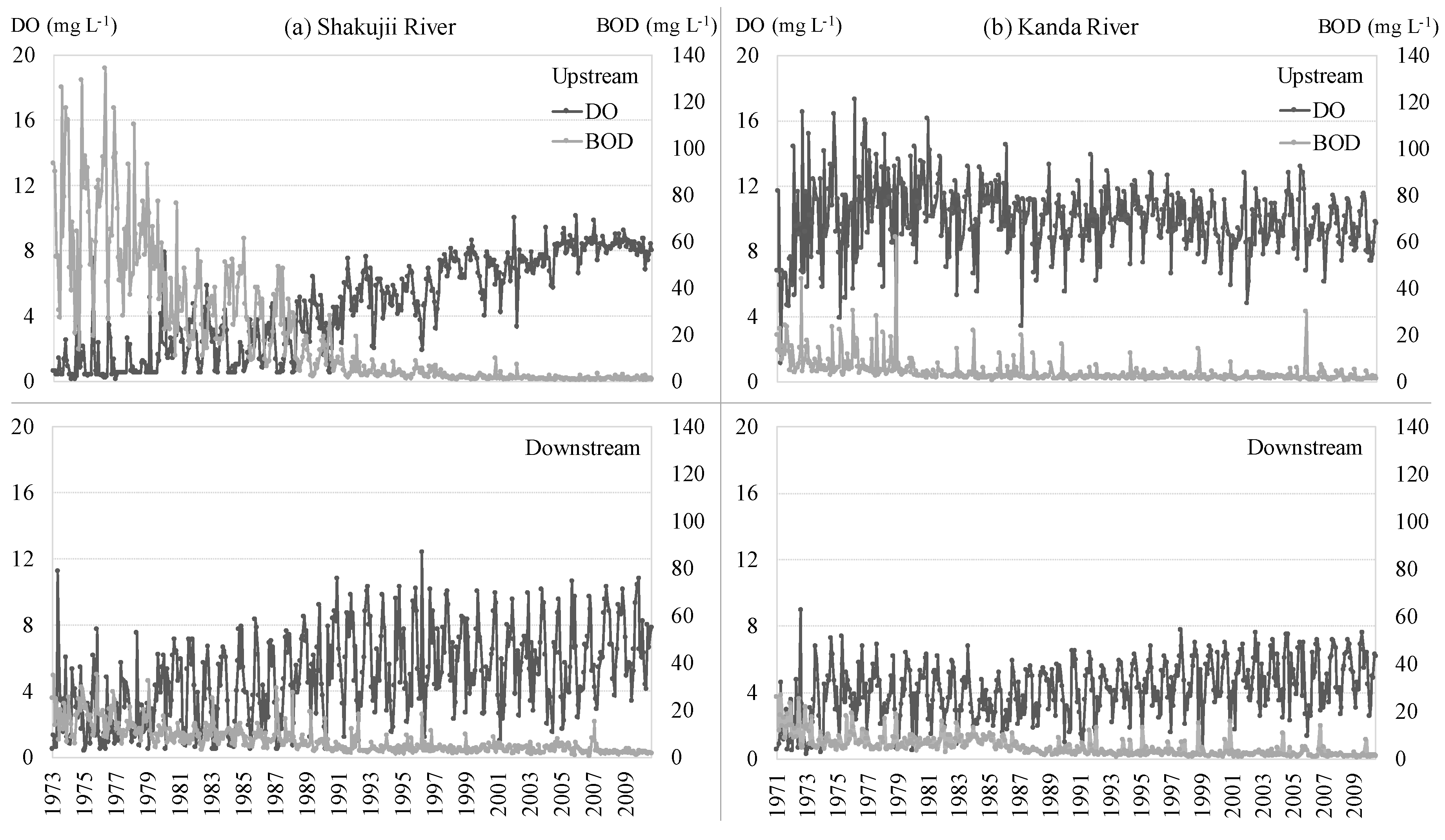
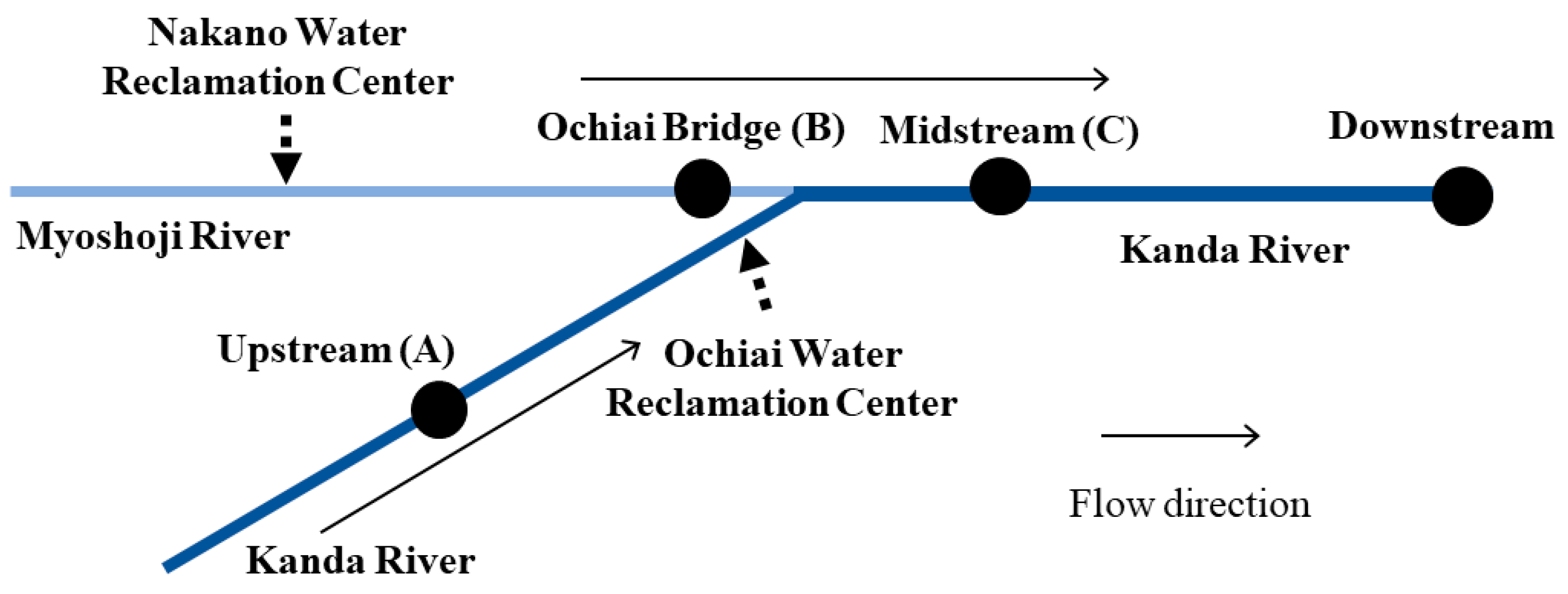

| Consolidated Group | Original Record |
|---|---|
| Aromatic | Aroma, Detergent |
| Chemical/oil | Chemical, Oil |
| Earthy/musty | Earth, Mold |
| Fishy | Fishy |
| Foul/rotten | Foul, Hydrogen sulfide, Rotten, Sewage |
| Plant | Grass, Plant, Sea grass, Water plant |
| None | Odorless |
| River | DO (mg L−1) | BOD (mg L−1) | |||||
|---|---|---|---|---|---|---|---|
| Mean | 75th Percentile | Minimum | Mean | 75th Percentile | Maximum | ||
| 1970s | Shakujii | 2.1 | 2.9 | 0.1 | 38.5 | 54.0 | 170.0 |
| 1980s | 4.3 | 5.9 | 0.5 | 16.3 | 21.0 | 76.0 | |
| 1990s | 7.7 | 10.3 | 0.5 | 3.8 | 4.3 | 28.0 | |
| 2000s | 8.2 | 10.1 | 1.0 | 2.0 | 2.3 | 15.0 | |
| 1970s | Kanda | 7.0 | 8.9 | 0.3 | 13.1 | 17.0 | 62.0 |
| 1980s | 7.3 | 9.5 | 0.5 | 7.3 | 10.0 | 29.0 | |
| 1990s | 7.4 | 9.3 | 0.5 | 3.8 | 4.5 | 20.0 | |
| 2000s | 7.6 | 9.1 | 0.5 | 2.4 | 2.5 | 30.0 | |
| Coefficient | OR | t-Value | |
|---|---|---|---|
| April–September | −0.52 | 0.59 | −11.96 ** |
| October–December | −0.25 | 0.78 | −4.97 ** |
| Constant | 1.84 | 51.91 ** |
| Shakujii | Kanda | Expected Sign | |||||
|---|---|---|---|---|---|---|---|
| Coefficient | Coefficient | OR | z-Value | Coefficient | OR | z-Value | |
| DO model | |||||||
| Downstream (dummy) | 0.27 | 1.31 | 9.61 ** | 1.31 | 3.69 | 9.98 ** | + |
| DO conc. | −0.13 | 0.87 | 5.17 ** | 0.16 | 1.18 | 7.64 ** | - |
| Constant | 0.61 | 1.84 | −11.23 ** | −1.79 | 0.17 | −8.36 ** | |
| pseudo R2 | 0.16 | 0.15 | |||||
| BOD model | |||||||
| Downstream (dummy) | 0.55 | 1.73 | 10.37 ** | 0.43 | 1.53 | 2.83 ** | + |
| BOD conc. | 0.02 | 1.02 | 15.66 ** | −0.06 | 0.94 | 11.73 ** | + |
| Constant | −0.49 | 0.62 | −10.44 ** | 0.10 | 1.10 | −11.69 ** | |
| pseudo R2 | 0.27 | 0.21 | |||||
© 2018 by the authors. Licensee MDPI, Basel, Switzerland. This article is an open access article distributed under the terms and conditions of the Creative Commons Attribution (CC BY) license (http://creativecommons.org/licenses/by/4.0/).
Share and Cite
Sado-Inamura, Y.; Fukushi, K. Considering Water Quality of Urban Rivers from the Perspectives of Unpleasant Odor. Sustainability 2018, 10, 650. https://doi.org/10.3390/su10030650
Sado-Inamura Y, Fukushi K. Considering Water Quality of Urban Rivers from the Perspectives of Unpleasant Odor. Sustainability. 2018; 10(3):650. https://doi.org/10.3390/su10030650
Chicago/Turabian StyleSado-Inamura, Yukako, and Kensuke Fukushi. 2018. "Considering Water Quality of Urban Rivers from the Perspectives of Unpleasant Odor" Sustainability 10, no. 3: 650. https://doi.org/10.3390/su10030650




